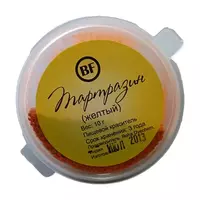Natural food dye yellow "tartrazine"

Natural food dyes have been used by humanity for more than a thousand years. Their appearance was due to the need to give the final product a more pleasant color. With the development of marketing and the food industry, they do not do without dyes at all. Surely your attention will be able to attract the natural food dye yellow "Tartrazine. " On products, it is indicated by the abbreviation "E10
2. "
Tartrazine is one of the cheapest dyes. It turns out, oddly enough, from the waste of coal mining - coal tar. The main area of use of the substance is the food industry. There, it is added to food, giving them a characteristic yellow color. Tartrazine is characterized by its light solubility in water. For this reason, it is often mixed with other dyes to obtain other shades and colors.
Natural food dye yellow "Tartrazine" usually does not tolerate sunlight. In a short period of time, it manages to break up into simple chemical compounds. To keep its properties as long as possible, tartrazine is kept in a special glass or enameled dish with tinted walls (sunlight is not allowed in). For a long time, the dye was banned in North America and European countries, but in the 80s of the XX century, the attitude towards it was revised. As a result, the active coloring compound is present in the food industry worldwide.
Most often, the natural food dye yellow "Tartrazine" is found in drinks of yellow shades. It is no less common in confectionery products - jams, cakes, cakes, sweets, ice cream, jelly, etc. You can meet tartrazine in all kinds of preservation, including fruits, vegetables or mustard. The supplement has become so popular that it is even present in some fermented milk products, for example, yogurts. Instant soups and mashed potatoes, ready-made breakfasts, some bakery products - everywhere you can see the additive "E10
2. "
The success of tartrazine is mainly due to its cheapness. Many scientists still argue about its effect on the human body. Some countries, fearing negative influence, even banned the use of the additive in the food industry. With excessive use of tartrazine, urticaria, Merkelsson-Rosenthal syndrome, skin rashes and a number of other ailments may appear. For this reason, the additive should be used carefully and in strictly permissible quantities.
natural food dye yellow "tartrazine" kCal
The energy value of the natural food dye of yellow "tartrazine" (Ratio of proteins, fats, carbohydrates - ju):
Proteins: g (~ 0 kCal)
Fats: g (~ 0 kCal)
Carbohydrates: g (~ 0 kCal)
 Español
Español Français
Français Português
Português Русский
Русский 简体中文
简体中文 繁體中文
繁體中文 日本語
日本語 한국어
한국어 العربية
العربية Türkçe
Türkçe Қазақ
Қазақ Deutsch
Deutsch Italiano
Italiano Українська
Українська
